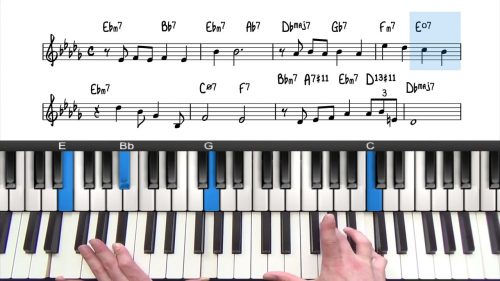Someone To Watch Over Me: Beginner Tutorial
Welcome to this jazz standard tutorial on the famous Gershwin composition “Someone To Watch Over Me”
The tune follows a standard 32 bar AABA form and there is also a 24 bar introduction which we are going to include in the arrangement. We will be arranging the tune in a slow ballad style in the original key of Eb Major.
Always Learn The Lyrics
If you are not already familiar with the lyrics, then I’d highly recommend that you spend some time to listen to the notable vocal versions.
Learning and memorising the lyrics will help you with phrasing the melody and also express the meaning of the lyrics musically in your performance.
Beginner & Advanced Tutorials
There are a series of tutorials for this tune. This one is beginner-focused. We stick to mostly simple voicings containing the root, the 3rd, and the 7th with the melody on top in our right hand.
The harmony and chord changes in this tune are quite challenging in places and so be aware that it is a difficult tune for beginners.
This tune was so highly-voted in the PianoGroove Community area that we wanted to ensure there is a tutorial for all levels of student. This is why it has been included here in the beginner course.
This lesson is also a nice illustration of the importance of the theory exercises in this course such as triad and 7th chord inversions.
Moving Onto To The Advanced Lessons
The other lessons on this tune are much more advanced where we create a complex solo piano arrangement. Check out those lessons here:
If you are new to jazz piano, continue to progress through PianoGroove’s Beginner Syllabus. Try out the advanced tutorials on this tune at a later date once you are comfortable with chord extensions, rootless voicings, and altered harmony.
Practice Tips
-
This lesson illustrates the importance of learning triad and 7th chord inversions as directed earlier in the Jazz Piano Foundations course.
-
Having a good awareness of inversions will help you to read and interpret lead sheets and will give you strong foundations for further jazz study.
-
In this lesson we introduce the 1-6-2-5 progression which is one of the most common progressions in jazz music. Check out the related lesson above for more information.
-
This lesson also introduces slash notation which can be challenging for beginners. Again check out the related lesson above which will give you more insight into this type of voicing.
-
Diminished theory is a vast and fascinating subject. For the purpose of this lesson, we did not go into too much detail. Check out the 'diminished chord basics' lesson above to further your understanding of this type of chord.







Lots in here and in the advanced lessons of this tune, thank you Hayden for this.
I absolutely loved this tutorial. Some things are finally starting to click in my mind. I actually have taken a bit of time away from the piano and committed to just watching these for a few weeks and now I’m getting excited to get back to applying it on the actual keys. It’s been surprising how much theory I’m able to learn without even actually playing. And the diminished and 1625 lesson on this song was so helpful. Thanks again for the great walk through.
My pleasure Ashton.
Yes we can absolutely learn a lot whilst away from the piano.
Another nice exercise is to search “Someone To Watch Over Me Piano” on Spotify or YouTube and listen to all of the different recordings.
Try to follow along with the record and imagine where you are in the form… the introduction, the 1st A Section, the 2nd A Section, the B Section etc… and try to visualise this when listening.
You might also like to check out this lesson on common jazz forms: pianogroove.com/jazz-piano-lessons/common-jazz-forms/ – it’s very useful information when trying to memorise tunes and build out our repertoire.
Enjoy the lessons!
Cheers,
Hayden
Hayden, thanks for including this lovely song in the beginner course despite its more complex harmony, and thanks for also including the 24-bar intro. Would like to see more of these intros in future lessons even though in many performances they are partially or totally left out.
Thank you also for exposing us to more advanced topics such as diminished chord harmony and slash/inverted chords to create a smoother descending bass line — and for hammering home the importance of learning inversions well. Your repetition of key concepts is also bearing fruit — the flat seventh going down a half step to become the major third of the next chord in a 2 5 1 progression is forever engraved in my mind and now hands.
Hi Humberto 👋
Apologies for the late reply here and I’m glad you enjoyed the lesson.
We have 2 more advanced lesson on the introduction and also the full arrangement, check those lesson out here:
Advanced Intro: pianogroove.com/jazz-piano-lessons/someone-to-watch-over-me-intro/
Advanced Arrangement: pianogroove.com/jazz-piano-lessons/someone-to-watch-over-me-tutorial/
I agree with you that the introductions are a lovely addition to the songs and create a fuller performance.
Thanks for the comments and I’m happy to hear on your progress with the 251 progressions.
Cheers,
Hayden
Hayden, thanks for your reply and for the links to the more advanced arrangements! Humberto
Thank you Hayden
It’s always enriching and a pleasure to follow your lessons. I’m making progress
Hi Rino,
That’s great news – I’m glad to hear on your progress.
If you’d like to see how far we can develop these tunes, check out the intermediate/advanced tutorials that I reference in my comment above to Humberto.
Cheers,
Hayden